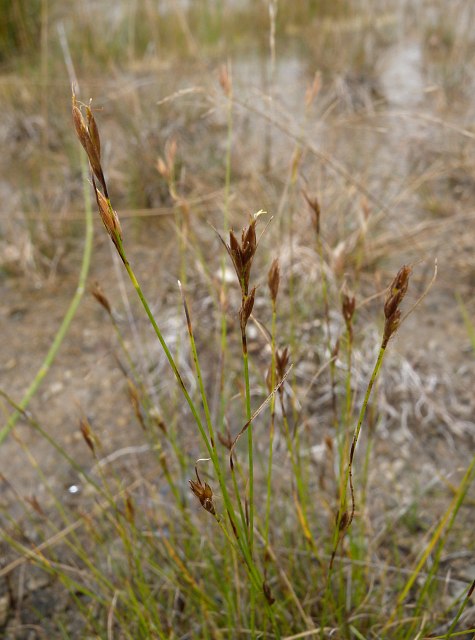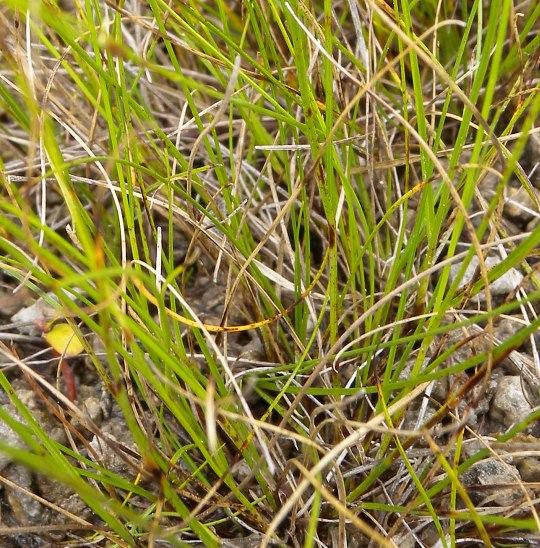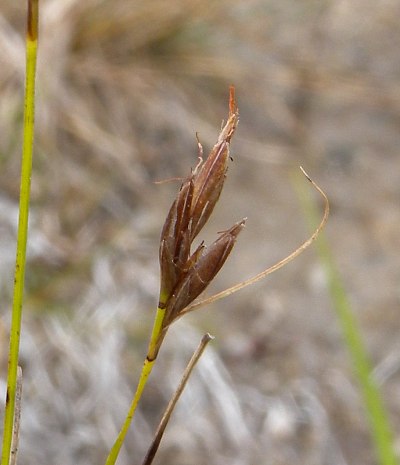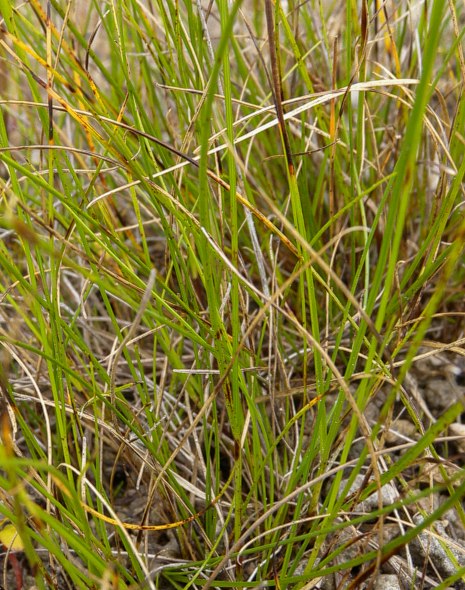
Each floret has 2-3 stamens with pale yellow anthers and a style with a bifurcated white tip; unisexual florets occur on rare occasions. Beneath each cluster of spikelets, there are narrow leafy bracts up to ½" (12 mm.) long; except for their smaller size, they resemble the leaf blades. The blooming period occurs from mid-summer to early autumn, lasting about 2-3 weeks for a colony of plants. The florets are cross-pollinated by the wind. Afterwards, fertile florets are replaced by beaked seeds about 2.5–3 mm. long (one beaked seed per fertile floret). The body of each beaked seed is 1.5–2 mm. long, while the tubercle at its apex is 1–1.5 mm. long. The seed body is oblanceoloid in shape, somewhat flattened, and smooth, while its tubercle is narrowly trianguloid and somewhat flattened. Originating from the base of the seed body, there are 6 slender bristles that extend upward beyond the seed body to the tubercle, and sometimes a little beyond the tubercle. These bristles usually have minute retrorse (downwardly pointed) barbs along their sides, although sometimes they are smooth. The root system consists of a crown of fibrous roots and short slender rhizomes.

Cultivation: The preference is full sun, consistently damp to wet conditions, and barren soil containing calcareous sand, limestone gravel, or marl (calcareous mud). This sedge does not tolerate much competition from other ground vegetation.
Range & Habitat: Hair Beakrush (Rhynchospora capillacea) occurs in NE Illinois, where it is native and rare (see Distribution Map). This sedge was collected once in St. Clair county in SW Illinois over one century ago, but it has not been observed in this area of the state since that time. Hair Beakrush occurs in widely scattered areas of NE USA, Midwestern USA, and several provinces in Canada. Habitats include grassy fens, marly pannes, calcareous seeps, sand flats along Lake Michigan, interdunal swales along Lake Michigan, and damp limestone cliffs. In Illinois, this conservative species is found primarily in high quality calcareous wetlands.

Faunal Associations: A small number of insects have been reported to feed on Beakrushes (Rhynchospora spp.). These insect species include Sphenophorus callosus (Southern Corn Billbug), Sphenophorus costicollis (Sedge Billbug), Dorydiella kansana (Kansan Leafhopper), the larvae of Euphyes dukesi (Duke's Skipper), and the larvae of a butterfly, Satyrodes appalachia (Appalachian Brown); see Vaurie (1983), Landis et al. (2011), and Barnes (1999) for more information. It is possible that some waterfowl and rails occasionally feed on the seeds of Beakrushes.
Photographic Location: On limestone gravel along a marly panne in Lake County, Illinois. This marly panne was in a particularly wet area of a fen.

Comments: In spite of the common name, 'Beakrush', this plant is actually a sedge (Cyperaceae). Common names for Rhynchospora capillacea are Needle Beaksedge, Horned Beakrush, and Hair Beakrush. The last common name is the one that is used here. Hair Beakrush can be readily distinguished from other Beakrushes (Rhynchospora spp.) in Illinois by its very narrow leaves (about 0.5 mm. in width). In general, Beakrushes can be distinguished from other sedges by the long conical or trianguloid tubercles of their seeds; these tubercles are longer than the corresponding seed bodies in some species. Spikerushes (Eleocharis spp.) also have these tubercles on their seed bodies, but their tubercles are shorter and more flattened than those Beakrushes, and they lack leaf blades.